Glacier movement (Agricultural & Resource Economics)
Glacier movement
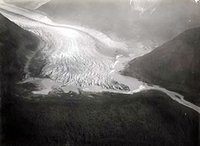 Wright Glacier, Alaska, British Columbia.1934. (Photographer unknown. 1934. From the Glacier Photograph Collection. Boulder, CO: National Snow and Ice Data Center). (Source: NSIDC)
Wright Glacier, Alaska, British Columbia.1934. (Photographer unknown. 1934. From the Glacier Photograph Collection. Boulder, CO: National Snow and Ice Data Center). (Source: NSIDC) 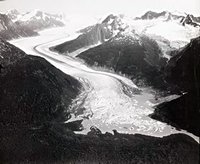 Wright Glacier, Alaska, British Columbia.1948. (Photographer unknown. 1948. From the Glacier Photograph Collection. Boulder, CO: National Snow and Ice Data Center) (Source: NSIDC)
Wright Glacier, Alaska, British Columbia.1948. (Photographer unknown. 1948. From the Glacier Photograph Collection. Boulder, CO: National Snow and Ice Data Center) (Source: NSIDC) Glacier movement is intrinsic to the concept of a glacier, since motion and change define a glacier's life. Glacial ice advances, then retreats. Glaciers grow and shrink in response to changing climate. Typically glacier movement and shape shifting occur over long periods of time (hundreds to thousands of years), but within historic memory such transformations in fewer than 100 years are not unknown.
Not all glaciers move slowly. For example, surging glaciers experience dramatic increases in flow rate, sometimes traveling as much as ten to one hundred times faster than the normal rate of movement.
By their movement, glaciers mark change and for this reason - among others - scientists study glaciers. By monitoring glaciers over time and around the world, researchers construct valuable records of glacial activity and their response to climate variation.
By comparing contemporary observations with historical and environmental records, such as agricultural records, pre-historic temperature or climate profiles, {C}glaciologists acquire and provide an enhanced understanding of global processes and change.
Growing Years
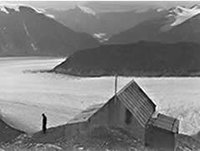 Chickamin Glacier, bounded by mountains on both sides, flows past a cabin in this photograph taken in 1941. Located in the coastal mountains shared by southeast Alaska and British Columbia, Canada. (Photograph by USGS/L.C. Reed at the World Data Center for Glaciology) (Source: NSIDC)
Chickamin Glacier, bounded by mountains on both sides, flows past a cabin in this photograph taken in 1941. Located in the coastal mountains shared by southeast Alaska and British Columbia, Canada. (Photograph by USGS/L.C. Reed at the World Data Center for Glaciology) (Source: NSIDC)  Leconte Glacier as seen in 1929. (Photographer unknown. 1929. From the Glacier Photograph Collection. Boulder, CO: National Snow and Ice Data Center) (Source: NSIDC)
Leconte Glacier as seen in 1929. (Photographer unknown. 1929. From the Glacier Photograph Collection. Boulder, CO: National Snow and Ice Data Center) (Source: NSIDC) Glacier movement occurs after snow accumulates over time turning to ice; eventually the glacial ice begins to flow outwards and downwards under the pressure of its own weight.
In polar and high-altitude alpine regions, glaciers generally accumulate more snow in the winter than they lose in the summer from melting, ablation, or calving. If the accumulated snow survives one melt season, it is considered to be firn. The snow and firn are compressed by the overlying snow, and the buried layers slowly grow together to form a thickened mass of ice.
The pressure created from the overlying snow compacts the underlying layers, and the snow grains become larger ice crystals randomly oriented in connected air spaces. These ice crystals can eventually grow to become several centimeters in diameter.
As compression continues and the ice crystals grow, the air spaces in the layers decrease, becoming small and isolated. This dense glacial ice usually looks somewhat blue. The glacier story continues as the glacier, now grown, begins moving forward and downward.
Moving Forward
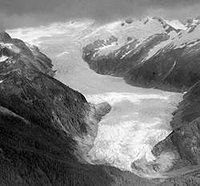 Muddy River Glacier snakes through the mountains near Frederick Sound, British Columbia, (Photograph by US Navy at the World Data Center for Glaciology) (Source: NSIDC)
Muddy River Glacier snakes through the mountains near Frederick Sound, British Columbia, (Photograph by US Navy at the World Data Center for Glaciology) (Source: NSIDC)  Glacier National Park, located in Montana, USA, shows a variety of glaciated valleys. Part of this mountain has literally been cut away by a glacier that has long since retreated. (Photograph by US Air Force 1925 at the World Data Center for Glaciology) (Source: NSIDC)
Glacier National Park, located in Montana, USA, shows a variety of glaciated valleys. Part of this mountain has literally been cut away by a glacier that has long since retreated. (Photograph by US Air Force 1925 at the World Data Center for Glaciology) (Source: NSIDC) Under the pressure of its own weight and the forces of gravity, a glacier will begin to move, or flow, outwards and downwards. Valley glaciers flow down valleys, and continental glaciers (ice sheets) flow outward in all directions from a central point.
Glacier move by internal deformation and/or by sliding at the base. Internal deformation occurs when the weight and mass of a glacier causes it to spread out due to gravity. Sliding occurs when the glacier slides on a thin layer of water at the bottom of the glacier.
This water may come from glacial melting due to the pressure of the overlying ice, or from water that has worked its way through cracks in the glacier. Glaciers can also readily slide on a soft sediment bed that has some water in it. Basal slip may account for most of the movement of thin, cold glaciers on steep slopes, or only 10 to 20 percent of the movement of warm, thick glaciers lying on gentle slopes.
When a glacier moves rapidly, internal stresses build up in the ice which cannot be relieved by deformation alone, and cracks (called crevasses) form at the surface of the glacier.
Glaciers dramatically impact their surrounding environment by reshaping the underlying and surrounding landscape as they move, through both erosion and deposition.
Glaciers erode the rock underneath them. A glacier can "carve" a valley, wearing away rocks and soil through abrasion and plucking up and moving large pieces of rock and debris. The glacier pushes this earth and rock forward as it advances, almost like a conveyor belt, and dumps it to the side along the way or at the end of the glacier (deposition). Depositional features include moraines, drumlins, and eskers.
The glacier story concludes as the glacier stops growing and actually begins to move In Retreat.
In Retreat
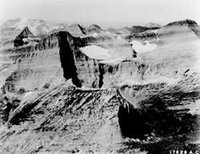 Glaciers carved many of the mountains and landforms seen in present-day Glacier National Park. A small glacier remained in the uppermost cirque (bowl-shaped hollow). (Photograph by Army Air Corps/Captain A. W. Stevens 1925 at the World Data Center for Glaciology) (Source: NSIDC)
Glaciers carved many of the mountains and landforms seen in present-day Glacier National Park. A small glacier remained in the uppermost cirque (bowl-shaped hollow). (Photograph by Army Air Corps/Captain A. W. Stevens 1925 at the World Data Center for Glaciology) (Source: NSIDC) 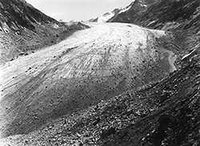 Forno Glacier, from an 1896 photograph. Notice the small rocks and boulders scattered across the surface of the glacier, as well as the pile of till in front of the glacier. (Photograph by H.F. Reid at the World Data Center for Glaciology) (Source: NSIDC)
Forno Glacier, from an 1896 photograph. Notice the small rocks and boulders scattered across the surface of the glacier, as well as the pile of till in front of the glacier. (Photograph by H.F. Reid at the World Data Center for Glaciology) (Source: NSIDC) As large glaciers retreat, the underlying ground surface is typically scoured of most materials, leaving only scars on the underlying surface.
Glacier retreat, melt, and ablation, result from increasing temperature, evaporation, and wind scouring. Ablation is a natural and seasonal part of glacier life. As long as {C}snow accumulation equals or is greater than melt and ablation, glacier health is maintained.
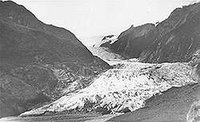 Franz Joseph Glacier (Unattributed photograph, 1951, at the World Data Center for Glaciology) (Source: NSIDC)
Franz Joseph Glacier (Unattributed photograph, 1951, at the World Data Center for Glaciology) (Source: NSIDC) The Franz Josef Glacier in New Zealand retreated rapidly over a fifteen year period during the 1950s and 1960s.
In the northern half of {C}North America, glacial remnants from the last ice age may be reincarnated as {C}vegetated hillsides. Views from an airplane window over the midwestern states and provinces reveal lines of {C}eskers and herds of {C}drumlins dotting the landscape.
Throughout advance and retreat, glacial debris (till) is jostled in all directions. Till is thrust forward with the glacier, brushed aside as the glacier pushes past less mobile objects, such as a mountainside, or drawn along on the glacier's journey.
Over the past 60 to 100 years, glaciers worldwide have tended toward retreat. Alpine glaciers, which are typically smaller and less stable to begin with, seem particularly susceptible to glacial retreat. Whether this is due to a predictable climate trend or because of increased human impacts on global climate remains to be determined.
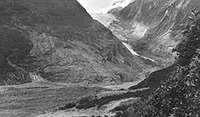 Franz Joseph Glacier (Unattributed photograph, 1964, at the World Data Center for Glaciology) (Source: NSIDC)
Franz Joseph Glacier (Unattributed photograph, 1964, at the World Data Center for Glaciology) (Source: NSIDC) | Disclaimer: This article contains information that was originally published by the National Snow and Ice Data Center. Topic editors and authors for the Encyclopedia of Earth have edited its content and added new information. The use of information from the National Snow and Ice Data Center should not be construed as support for or endorsement by that organization for any new information added by EoE personnel, or for any editing of the original content. |
